A Comparative Analysis of Academic Entrepreneurship Research: The Cases of Bulgaria, Malta, and Turkey
Abstract
1. Introduction
- -
- What are students’ attitudes toward entrepreneurship as a potential career path?
- -
- How does entrepreneurship education affect students’ motivation to engage in entrepreneurial activities?
- -
- In what ways can universities contribute to the commercialization of scientific potential through entrepreneurship?
- -
- How does the presence of a strong entrepreneurial culture within educational institutions influence students’ perspectives and their ability to form lasting business partnerships?
2. Literature Review
2.1. Theoretical Framework of Entrepreneurship
2.2. Importance of Academic Entrepreneurship and Education
2.3. The Moderating Role of Entrepreneurship Inspiration
3. Methodology
3.1. Data Collection and Sampling Framework
3.2. Conceptual Framework and Estimation Strategy
3.3. The Overall Reliability of the Attitudes Toward Own Business Scale
4. Statistical Analyses of the Results
5. Discussion
6. Conclusions
6.1. Theoretical and Practical Implications
6.2. Limitations and Future Research Directions
6.2.1. Limitations
6.2.2. Future Research Directions
6.3. Institutional Support
Author Contributions
Funding
Institutional Review Board Statement
Informed Consent Statement
Data Availability Statement
Conflicts of Interest
Appendix A. Survey Questionnaire Details
- -
- I agree to participate [Go to the beginning of the survey]
- -
- I do not wish to participate [Go to the end of the survey]
| To What Extent Are You Interested in the Jobs Listed Below? | ||||
| Not Interested at All 1 | Not Interested 2 | Interested 3 | Very Interested 4 | |
| Full-time employment | ◯ | ◯ | ◯ | ◯ |
| Part-time employment | ◯ | ◯ | ◯ | ◯ |
| Self-employment (individual work for own account)) | ◯ | ◯ | ◯ | ◯ |
| Combined full-time employment and self-employment | ◯ | ◯ | ◯ | ◯ |
| Combined part-time employment and self-employment | ◯ | ◯ | ◯ | ◯ |
| Micro business (employing less than 10 people) | ◯ | ◯ | ◯ | ◯ |
| Small business (employing less than 50 people) | ◯ | ◯ | ◯ | ◯ |
| Medium-sized business (employing less than 250 people) | ◯ | ◯ | ◯ | ◯ |
| Large business (employing more than 250 people) | ◯ | ◯ | ◯ | ◯ |
| Co-operatives | ◯ | ◯ | ◯ | ◯ |
| Other jobs | ◯ | ◯ | ◯ | ◯ |
| If You Decide to Open Your Own Business, FROM WHOM WOULD YOU EXPECT SUPPORT? | ||||
| Definitely Yes 4 | Probably Yes 3 | Probably No 2 | Definitely No 1 | |
| … University staff (e.g., professors, lectures etc.) | ◯ | ◯ | ◯ | ◯ |
| … Post-secondary professors and lecturers | ◯ | ◯ | ◯ | ◯ |
| … Secondary school teachers | ◯ | ◯ | ◯ | ◯ |
| … Parents | ◯ | ◯ | ◯ | ◯ |
| … Relatives | ◯ | ◯ | ◯ | ◯ |
| … Friends | ◯ | ◯ | ◯ | ◯ |
| … Educational institutions | ◯ | ◯ | ◯ | ◯ |
| … Technology transfer office at your university | ◯ | ◯ | ◯ | ◯ |
| … Other organizations | ◯ | ◯ | ◯ | ◯ |
| What Kind of SUPPORT Is Most Important for People Who Intend to Start Their Own Business, and Who Can Provide This Kind of Support? |
| Who Inspires Young People to Start Their Businesses, and to What Extent? | ||||
| Not at All | Very Little | Somewhat | To a Great Extent | |
| Own initiative of young people | ◯ | ◯ | ◯ | ◯ |
| Successful local business owners | ◯ | ◯ | ◯ | ◯ |
| Some widely known business owners | ◯ | ◯ | ◯ | ◯ |
| Secondary school teachers | ◯ | ◯ | ◯ | ◯ |
| University professors | ◯ | ◯ | ◯ | ◯ |
| Parents | ◯ | ◯ | ◯ | ◯ |
| Relatives | ◯ | ◯ | ◯ | ◯ |
| Friends | ◯ | ◯ | ◯ | ◯ |
| Educational institutions | ◯ | ◯ | ◯ | ◯ |
| Technology transfer office | ◯ | ◯ | ◯ | ◯ |
| Other organizations | ◯ | ◯ | ◯ | ◯ |
| If You Want to Start Your Business, WHAT KIND OF BUSINESS DO YOU WANT TO START? |
| For Each Pair of Adjectives, Please SELECT the Point That Best Describes Your Opinions About OWNING A PRIVATE BUSINESS. | ||||||||
| 1 | 2 | 3 | 4 | 5 | 6 | 7 | ||
| Interesting | ◯ | ◯ | ◯ | ◯ | ◯ | ◯ | ◯ | Uninteresting |
| Innovative | ◯ | ◯ | ◯ | ◯ | ◯ | ◯ | ◯ | Traditional |
| Profitable | ◯ | ◯ | ◯ | ◯ | ◯ | ◯ | ◯ | Unprofitable |
| Exciting | ◯ | ◯ | ◯ | ◯ | ◯ | ◯ | ◯ | Boring |
| Safe | ◯ | ◯ | ◯ | ◯ | ◯ | ◯ | ◯ | Risky |
| Realistic | ◯ | ◯ | ◯ | ◯ | ◯ | ◯ | ◯ | Unrealistic |
| Sustainable | ◯ | ◯ | ◯ | ◯ | ◯ | ◯ | ◯ | Unsustainable |
| Creative | ◯ | ◯ | ◯ | ◯ | ◯ | ◯ | ◯ | Uncreative |
| Pleasant | ◯ | ◯ | ◯ | ◯ | ◯ | ◯ | ◯ | Unpleasant |
| Good | ◯ | ◯ | ◯ | ◯ | ◯ | ◯ | ◯ | Bad |
| Active | ◯ | ◯ | ◯ | ◯ | ◯ | ◯ | ◯ | Passive |
| Strong | ◯ | ◯ | ◯ | ◯ | ◯ | ◯ | ◯ | Weak |
| Easy | ◯ | ◯ | ◯ | ◯ | ◯ | ◯ | ◯ | Difficult |
| For Each Pair of Adjectives, Please SELECT the Point That Best Describes Your Opinion About WORKING FOR SOMEBODY ELSE. | ||||||||
| 1 | 2 | 3 | 4 | 5 | 6 | 7 | ||
| Interesting | ◯ | ◯ | ◯ | ◯ | ◯ | ◯ | ◯ | Uninteresting |
| Innovative | ◯ | ◯ | ◯ | ◯ | ◯ | ◯ | ◯ | Traditional |
| Profitable | ◯ | ◯ | ◯ | ◯ | ◯ | ◯ | ◯ | Unprofitable |
| Exciting | ◯ | ◯ | ◯ | ◯ | ◯ | ◯ | ◯ | Boring |
| Safe | ◯ | ◯ | ◯ | ◯ | ◯ | ◯ | ◯ | Risky |
| Realistic | ◯ | ◯ | ◯ | ◯ | ◯ | ◯ | ◯ | Unrealistic |
| Sustainable | ◯ | ◯ | ◯ | ◯ | ◯ | ◯ | ◯ | Unsustainable |
| Creative | ◯ | ◯ | ◯ | ◯ | ◯ | ◯ | ◯ | Uncreative |
| Pleasant | ◯ | ◯ | ◯ | ◯ | ◯ | ◯ | ◯ | Unpleasant |
| Good | ◯ | ◯ | ◯ | ◯ | ◯ | ◯ | ◯ | Bad |
| Active | ◯ | ◯ | ◯ | ◯ | ◯ | ◯ | ◯ | Passive |
| Strong | ◯ | ◯ | ◯ | ◯ | ◯ | ◯ | ◯ | Weak |
| Easy | ◯ | ◯ | ◯ | ◯ | ◯ | ◯ | ◯ | Difficult |
| How Often Do You Think About the Following Activities Related to Your Future Work? | ||||||
| Never (1) | Rarely (2) | Seldom (3) | Sometimes (4) | Often (5) | ||
| 1 | Creating new ideas for complex issues | ◯ | ◯ | ◯ | ◯ | ◯ |
| 2 | Searching out new work methods, techniques, or instruments | ◯ | ◯ | ◯ | ◯ | ◯ |
| 3 | Generating original solutions for problems | ◯ | ◯ | ◯ | ◯ | ◯ |
| 4 | Discussing new ideas with your colleagues | ◯ | ◯ | ◯ | ◯ | ◯ |
| 5 | Acquiring approval for innovative ideas | ◯ | ◯ | ◯ | ◯ | ◯ |
| 6 | Making important people enthusiastic about your innovative ideas | ◯ | ◯ | ◯ | ◯ | ◯ |
| 7 | Transforming innovative ideas into useful applications | ◯ | ◯ | ◯ | ◯ | ◯ |
| 8 | Introducing innovative ideas into the work environment | ◯ | ◯ | ◯ | ◯ | ◯ |
| 9 | Evaluating the effectiveness of innovative ideas | ◯ | ◯ | ◯ | ◯ | ◯ |
| Would You Like to Learn Anything About the Following Activities Related to Your Future Work? | |||||
| Definitely No 1 | Probably No 2 | Probably Yes 3 | Definitely Yes 4 | ||
| 1 | Creating new ideas for complex issues | ◯ | ◯ | ◯ | ◯ |
| 2 | Searching out new work methods, techniques, or instruments | ◯ | ◯ | ◯ | ◯ |
| 3 | Generating original solutions for problems | ◯ | ◯ | ◯ | ◯ |
| 4 | Discussing new ideas with your colleagues | ◯ | ◯ | ◯ | ◯ |
| 5 | Acquiring approval for innovative ideas | ◯ | ◯ | ◯ | ◯ |
| 6 | Making important people enthusiastic about your innovative ideas | ◯ | ◯ | ◯ | ◯ |
| 7 | Transforming innovative ideas into useful applications | ◯ | ◯ | ◯ | ◯ |
| 8 | Introducing innovative ideas into the work environment | ◯ | ◯ | ◯ | ◯ |
| 9 | Evaluating the effectiveness of innovative ideas | ◯ | ◯ | ◯ | ◯ |
| How Would You Evaluate Your Knowledge and Skills About: | |||||
| Very Poor 1 | Poor 2 | Acceptable 3 | Good 4 | Very Good 5 | |
| Innovative work practices? | ◯ | ◯ | ◯ | ◯ | ◯ |
| Process innovation? | ◯ | ◯ | ◯ | ◯ | ◯ |
| Product innovation? | ◯ | ◯ | ◯ | ◯ | ◯ |
| Creating own start-up? | ◯ | ◯ | ◯ | ◯ | ◯ |
| Legislation for opening and managing own business? | ◯ | ◯ | ◯ | ◯ | ◯ |
| Accounting related to managing own business? | ◯ | ◯ | ◯ | ◯ | ◯ |
| Marketing of new products or services? | ◯ | ◯ | ◯ | ◯ | ◯ |
| Financial aspects of a business? | ◯ | ◯ | ◯ | ◯ | ◯ |
| Environmentally friendly or green business practices? | ◯ | ◯ | ◯ | ◯ | ◯ |
| Socially responsible businesses? | ◯ | ◯ | ◯ | ◯ | ◯ |
| Basic Aspects of Business Planning | Not at all Interested 1 | Not Interested 2 | Neither 3 | Interested 4 | Very Interested 5 |
| Development of entrepreneurship skills | ◯ | ◯ | ◯ | ◯ | ◯ |
| Information on business management | ◯ | ◯ | ◯ | ◯ | ◯ |
| Legislative and legal information | ◯ | ◯ | ◯ | ◯ | ◯ |
| Marketing and sales information | ◯ | ◯ | ◯ | ◯ | ◯ |
| Financial and accounting information | ◯ | ◯ | ◯ | ◯ | ◯ |
| Risk management | ◯ | ◯ | ◯ | ◯ | ◯ |
| Acquisition of financial support and resources | ◯ | ◯ | ◯ | ◯ | ◯ |
| Networking and business collaboration | ◯ | ◯ | ◯ | ◯ | ◯ |
| Human resources management | ◯ | ◯ | ◯ | ◯ | ◯ |
| Financial aspects of a business | ◯ | ◯ | ◯ | ◯ | ◯ |
| Environmentally friendly or green business practices | ◯ | ◯ | ◯ | ◯ | ◯ |
| Socially responsible businesses | ◯ | ◯ | ◯ | ◯ | ◯ |
| Other issues | ◯ | ◯ | ◯ | ◯ | ◯ |
| Please Indicate to What Exent Is Each Form of Learning About Entrepreneurship Suitable for You? | ||||||
| Not Suitable at All 1 | Not Suitable 2 | Neutral 3 | Suitable 4 | Very Suitable 5 | ||
| 1 | In-class lectures (30 h of lectures with a certification exam) | ◯ | ◯ | ◯ | ◯ | ◯ |
| 1 | Online lectures (30 h of lectures with a certification exam) | ◯ | ◯ | ◯ | ◯ | ◯ |
| 1 | Combined in-class and online lectures (30 h of lectures with a certification exam) | ◯ | ◯ | ◯ | ◯ | ◯ |
| 2 | Seminars (Short presentations by experts followed by discussions) | ◯ | ◯ | ◯ | ◯ | ◯ |
| 3 | Workshops (intensive group discussion and practical activity) | ◯ | ◯ | ◯ | ◯ | ◯ |
| 4 | Individualized guidance and mentoring on how to develop and manage one’s own business | ◯ | ◯ | ◯ | ◯ | ◯ |
| 5 | Self-directed learning (Individual reading about entrepreneurship) | ◯ | ◯ | ◯ | ◯ | ◯ |
| 6 | Other forms of learning | ◯ | ◯ | ◯ | ◯ | ◯ |
| For Each of the Following Factors, How Significant an Obstacle Do You Think It Is for Someone Starting a Private Business? | |||||
| Not Significant at All 1 | Not Significant 2 | Neither 3 | Significant 4 | Very Significant 5 | |
| Lack of entrepreneurship education during secondary school | ◯ | ◯ | ◯ | ◯ | ◯ |
| Lack of entrepreneurship education at post-secondary level | ◯ | ◯ | ◯ | ◯ | ◯ |
| Lack of entrepreneurship education during university | ◯ | ◯ | ◯ | ◯ | ◯ |
| Lack of own financial resources | ◯ | ◯ | ◯ | ◯ | ◯ |
| Lack of national institutional funding support | ◯ | ◯ | ◯ | ◯ | ◯ |
| Lack of funding support at the EU level | ◯ | ◯ | ◯ | ◯ | ◯ |
| Difficulty to access bank loans | ◯ | ◯ | ◯ | ◯ | ◯ |
| Lack of information about funding opportunities | ◯ | ◯ | ◯ | ◯ | ◯ |
| High risk to run one’s own business | ◯ | ◯ | ◯ | ◯ | ◯ |
| Lack of education about risk management | ◯ | ◯ | ◯ | ◯ | ◯ |
| Difficulties in developing a business plan | ◯ | ◯ | ◯ | ◯ | ◯ |
| Lack of knowledge of how to run own business | ◯ | ◯ | ◯ | ◯ | ◯ |
| Difficulties in finding business partners | ◯ | ◯ | ◯ | ◯ | ◯ |
| Difficulties in finding adequate employees | ◯ | ◯ | ◯ | ◯ | ◯ |
| Lack of knowledge about human resources management | ◯ | ◯ | ◯ | ◯ | ◯ |
- o
- Male
- o
- Female
- o
- Other
- o
- I prefer not to say
- o
- Undergraduate
- o
- Master
- o
- PhD
- o
- Other
- o
- Full-time
- o
- Part-time
- o
- Other
- o
- Usually weak
- o
- Below the average for my class
- o
- The average for my class
- o
- Above the average for my class
- o
- Usually top of my class
- o
- Bachelor’s degree
- o
- Master’s degree
- o
- Doctoral degree
- o
- Professional bachelor’s degree
- o
- Professional master’s degree
- o
- Employed Full-Time
- o
- Employed Part-Time
- o
- Self-employed
- o
- Seeking employment opportunities
- o
- I prefer not to say
- o
- Yes
- o
- No
- o
- Yes
- o
- No
- o
- Yes
- o
- No
- o
- Significantly below average
- o
- Below average
- o
- Average
- o
- Above average
- o
- Significantly above average
- o
- Do not know
- o
- Yes
- o
- No
- o
- Family members are not employed
- o
- Prefer not to answer
- o
- Rural area
- o
- Small city or town
- o
- Large city
- o
- Living with both parents
- o
- Living with one parent
- o
- Living by yourself
- o
- Living with friends
- o
- Living with a partner
- o
- Other arrangement
| What Is the Highest Level of Education That Your FATHER Completed? |
|
| What Is the Highest Level of Education That Your MOTHER Completed? |
|
| What Is the Employment Status of Your FATHER? |
|
| What Is the Employment Status of Your MOTHER? |
|
Appendix B
| Hypothesis | Theoretical Basis/Supporting Research |
| H1a: Entrepreneurship initiatives are adversely affected by the preference for full-time employment. H1b: Entrepreneurship initiatives benefit from a preference for self-employment or part-time work. | These hypotheses are grounded in the general theoretical framework of entrepreneurship, which encompasses psychological, sociological, and economic theories. The research challenges the binary view of employment versus entrepreneurship, suggesting students may see them as complementary or sequential paths, a perspective that aligns with the emergence of “hybrid” careers [62,71]. |
| H2a: Entrepreneurship initiatives are positively impacted by favorable assessments of owning a business. H2b: Entrepreneurship initiatives are negatively impacted by positive assessments of working for someone else. | These hypotheses are supported by the Theory of Planned Behavior (TPB), which emphasizes the role of positive attitude and perceived behavioral control in forming intentions. This is a consistent finding in the entrepreneurship literature [1,63,65,66,68]. |
| H3: Students depend on the ability of the university to assist them with their entrepreneurial initiatives. | This hypothesis is based on the critical role of the university as a central part of the entrepreneurial ecosystem. Studies indicate that university support programs enhance student confidence and reduce uncertainty. The “entrepreneurial university” paradigm highlights the university’s role in fostering student entrepreneurship through resources like incubators, mentorship, and applied courses [1,2,39,69,70,71,72]. |
| H4: Students favor practically oriented teaching strategies in learning entrepreneurship. | The literature points to a persistent gap between pedagogical methods and the hands-on, mentorship-driven experiences that students find most valuable. This echoes calls in existing research for experiential learning and active methodologies in entrepreneurship education [1,2,70,71,72]. |
| H5: The absence of entrepreneurship education in higher education is cited by students as a barrier to launching a private company. | This hypothesis relates to the significant impact of entrepreneurship education on students’ career paths. The discussion identifies the perceived lack of this education as a clear gap that universities must address [1,2,69,70,71,72]. |
| H6: The university has the potential to inspire young people toward entrepreneurship. | This hypothesis is linked to the “third mission” of higher education institutions, which includes their economic and social contributions. Recent studies suggest that inspiration is a critical moderating variable that translates motivation into tangible outcomes [52,58,67,73]. |
| H7a: Students whose parents run their own businesses are more likely to prefer running their own business. H7b: Students whose parents do not run their own businesses are more likely to prefer full-time employment. | These hypotheses are supported by the literature on the moderating effects of entrepreneurship inspiration, particularly the influence of an entrepreneurial family background. The findings align with social learning theory and the role model effect. Research suggests that having an entrepreneurial family background can serve as a strong moderator between education and passion for founding a business [48,74,75,76]. |
References
- Etzkowitz, H. MIT and the Rise of Entrepreneurial Science, 1st ed.; Routledge: London, UK, 2002. [Google Scholar]
- Clark, B.R. Creating Entrepreneurial Universities: Organizational Pathways of Transformation, 1st ed.; In Issues in Higher Education; IAU Press; Pergamon Press: Leeds, UK, 1998. [Google Scholar]
- Audretsch, D.B.; European Commission (Eds.) Entrepreneurship: A Survey of the Literature; Enterprise Papers No 14/2003; Publications Office: Luxembourg, 2003. [Google Scholar]
- Guerrero, M.; Urbano, D. The development of an entrepreneurial university. J. Technol. Transf. 2012, 37, 43–74. [Google Scholar] [CrossRef]
- Shane, S.A. Academic Entrepreneurship: University Spinoffs and Wealth Creation; Repr. in New Horizons in Entrepreneurship; Elgar: Cheltenham, UK, 2005. [Google Scholar]
- Slaughter, S.; Rhoades, G. Academic Capitalism and the New Economy: Markets, State, and Higher Education; the Johns Hopkins University Press: Baltimore, MD, USA, 2004. [Google Scholar]
- Bui, H.T.; Le, T.T.T.; Tran, A.K.T.; Tran, T.P.T.; Hoang, G.; Luu, T.T. Entrepreneurship education fostering entrepreneurial intentions: The serial mediation effect of resilience and opportunity recognition. J. Educ. Bus. 2025, 100, 69–80. [Google Scholar] [CrossRef]
- Lv, Y.; Chen, Y.; Sha, Y.; Wang, J.; An, L.; Chen, T.; Huang, X.; Huang, Y.; Huang, L. How Entrepreneurship Education at Universities Influences Entrepreneurial Intention: Mediating Effect Based on Entrepreneurial Competence. Front. Psychol. 2021, 12, 655868. [Google Scholar] [CrossRef]
- Yaneva, D.; Kiryakova-Dineva, T.; Bozkova, R. Needs for Remodeling the Entrepreneurship Education for the Post-COVID-19 Era. In Resilience and Economic Intelligence Through Digitalization and Big Data Analytics; Sciendo: Warsaw, Poland, 2021; pp. 244–253. [Google Scholar] [CrossRef]
- U.S. Department of Commerce. The Innovative and Entrepreneurial University: Higher Education, Innovation & Entrepreneurship in Focus; U.S. Department of Commerce, 2013. Available online: https://www.eda.gov/sites/default/files/files/tools/research-reports/The_Innovative_and_Entrepreneurial_University_Report.pdf (accessed on 10 February 2025).
- Hoog, S.O.; Skoumpopoulou, D. Entrepreneurship Education: Comparative Study of Initiatives of two Partner Universities. AJE 2019, 6, 307–328. [Google Scholar] [CrossRef]
- Davey, T.; Hannon, P.; Penaluna, A. Entrepreneurship education and the role of universities in entrepreneurship: Introduction to the special issue. Ind. High. Educ. 2016, 30, 171–182. [Google Scholar] [CrossRef]
- Vaicekauskaite, R.; Valackiene, A. The Need for Entrepreneurial Education at University. J. Teach. Educ. Sustain. 2018, 20, 82–92. [Google Scholar] [CrossRef]
- Suguna, M.; Sreenivasan, A.; Ravi, L.; Devarajan, M.; Suresh, M.; Almazyad, A.S.; Xiong, G.; Ali, I.; Mohamed, A.W. Entrepreneurial education and its role in fostering sustainable communities. Sci. Rep. 2024, 14, 7588. [Google Scholar] [CrossRef]
- Haruna, U.I. The Need for an Effective Collaboration Across Science, Technology, Engineering & Mathematics (STEM) Fields for a Meaningful Technological Development in Nigeria. J. Educ. Pract. 2015, 6, 16–21. [Google Scholar]
- Hahn, D.; Minola, T.; Van Gils, A.; Huybrechts, J. Entrepreneurial education and learning at universities: Exploring multilevel contingencies. Entrep. Reg. Dev. 2017, 29, 945–974. [Google Scholar] [CrossRef]
- Goldsmith, R.E.; Kerr, J.R. Entrepreneurship and adaptation-innovation theory. Technovation 1991, 11, 373–382. [Google Scholar] [CrossRef]
- Angelova, M.; Pastarmadzhieva, D.; Gammone, M.; Sidoti, F. Survey on Entrepreneurial Culture and Attitudes Across Students; Plovdiv University Press: Plovdiv, Bulgaria, 2024. [Google Scholar]
- McClelland, D.C. The Achieving Society; D Van Nostrand Company: New York, NY, USA, 1961. [Google Scholar] [CrossRef]
- Schumpeter, J.A. The Theory of Economic Development; Harvard University Press: Cambridge, MA, USA, 1934. [Google Scholar]
- Mishra, C.S.; Zachary, R.K. The Theory of Entrepreneurship. Entrep. Res. J. 2015, 5, 251–268. [Google Scholar] [CrossRef]
- Smallbone, D.; Friederike, W. Conceptualising entrepreneurship in a transition context. Int. J. Entrep. Small Bus. 2006, 3, 190–206. [Google Scholar] [CrossRef]
- de Wit, B.; Meyer, R. Strategy–Process, Content, Context: An International Perspective, 2nd ed.; International Thomson Business Press: London, UK; Boston, MA, USA, 1998. [Google Scholar]
- Brennan, M.C.; McGowan, P. Academic entrepreneurship: An exploratory case study. Int. J. Entrep. Behav. Res. 2006, 12, 144–164. [Google Scholar] [CrossRef]
- Perkmann, M.; Tartari, V.; McKelvey, M.; Autio, E.; Brostrom, A.; D’Este, P.; Fini, R.; Geuna, A.; Grimaldi, R.; Hughes, A.; et al. Universities and the third mission: A systematic review of research on external engagement by academic researchers. Res. Policy 2013, 42, 423–442. [Google Scholar] [CrossRef]
- Ekelund, R.B.; Kirzner, I.M. Competition and Entrepreneurship. South. Econ. J. 1974, 41, 155. [Google Scholar] [CrossRef]
- Kyurova, V.; Zlateva, D.; Koyundzhiyska-Davidkova, B.; Vladov, R.; Mierlus-Mazilu, I. Digital technologies as an opportunity for business development. Entrepreneurship 2023, 11, 43–57. [Google Scholar] [CrossRef]
- Mollov, Y.; Dakova, M.; Erturk-Mincheva, A. The just transition in Bulgaria–mission (im)possible. Ecol. Balk. 2024, 16, 119–127. [Google Scholar] [CrossRef]
- Galindo-Martín, M.-Á.; Castaño-Martínez, M.-S.; Méndez-Picazo, M.-T. Effects of the pandemic crisis on entrepreneurship and sustainable development. J. Bus. Res. 2021, 137, 345–353. [Google Scholar] [CrossRef]
- Fritsch, M. New Business Formation and Regional Development: A Survey and Assessment of the Evidence. FNT Entrep. 2013, 9, 249–364. [Google Scholar] [CrossRef]
- Mintzberg, H. Simply Managing: What Managers Do- and Can Do Better; Berrett-Koehler Publishers: San Francisco, CA, USA, 2013. [Google Scholar]
- Bezerra, C.M.D.S.; Ramos, H.R.; Shinohara, E.E.R.D.; Nassif, V.M.J. Entrepreneurial behavior and strategy: A systematic literature review. REGEPE Entrep. Small Bus. J. 2023, 12, e2396. [Google Scholar] [CrossRef]
- Audretsch, D.B.; Keilbach, M. The Theory of Knowledge Spillover Entrepreneurship*. J. Manag. Stud. 2007, 44, 1242–1254. [Google Scholar] [CrossRef]
- Autio, E.; Kenney, M.; Mustar, P.; Siegel, D.; Wright, M. Entrepreneurial innovation: The importance of context. Res. Policy 2014, 43, 1097–1108. [Google Scholar] [CrossRef]
- Doudna, J.A.; Charpentier, E. The new frontier of genome engineering with CRISPR-Cas9. Science 2014, 346, 1258096. [Google Scholar] [CrossRef]
- Rothaermel, F.T.; Agung, S.D.; Jiang, L. University entrepreneurship: A taxonomy of the literature. Ind. Corp. Change 2007, 16, 691–791. [Google Scholar] [CrossRef]
- Etzkowitz, H. The second academic revolution and the rise of entrepreneurial science. IEEE Technol. Soc. Mag. 2001, 20, 18–29. [Google Scholar] [CrossRef]
- Shane, S.A. A General Theory of Entrepreneurship: The Individual-Opportunity Nexus; Repr. in New Horizons in Entrepreneurship; Elgar: Cheltenham, UK, 2007. [Google Scholar]
- Schimperna, F.; Nappo, F.; Marsigalia, B. Student Entrepreneurship in Universities: The State-of-the-Art. Adm. Sci. 2021, 12, 5. [Google Scholar] [CrossRef]
- Stam, E.; Van De Ven, A. Entrepreneurial ecosystem elements. Small Bus Econ. 2021, 56, 809–832. [Google Scholar] [CrossRef]
- Collins, J. The Correlations Between Academic and Entrepreneur. Impactio. 15 October 2020. Available online: https://www.impactio.com/blog/the-correlations-between-academic-and-entrepreneur (accessed on 12 February 2025).
- Jafarov, N.; Szakos, J. Review of entrepreneurial ecosystem models. ASERC J. Socio-Econ. Stud. 2022, 5, 3–16. [Google Scholar]
- Mack, E.; Mayer, H. The evolutionary dynamics of entrepreneurial ecosystems. Urban Stud. 2016, 53, 2118–2133. [Google Scholar] [CrossRef]
- Spigel, B. The Relational Organization of Entrepreneurial Ecosystems. Entrep. Theory Pract. 2017, 41, 49–72. [Google Scholar] [CrossRef]
- Matthews, C.; Moser, S.B. A Longitudinal Investigation of the Impact of Family Background and Gender on Interest in Small Firm Ownership. J. Small Bus. Manag. 1996, 34, 29. [Google Scholar]
- Wyrwich, M.; Stuetzer, M.; Sternberg, R. Entrepreneurial role models, fear of failure, and institutional approval of entrepreneurship: A tale of two regions. Small Bus. Econ. 2016, 46, 467–492. [Google Scholar] [CrossRef]
- Nowiński, W.; Haddoud, M.Y. The role of inspiring role models in enhancing entrepreneurial intention. J. Bus. Res. 2019, 96, 183–193. [Google Scholar] [CrossRef]
- Lee, Y.; Cortes, A.F.; Joo, M. Entrepreneurship Education and Founding Passion: The Moderating Role of Entrepreneurial Family Background. Front. Psychol. 2021, 12, 743672. [Google Scholar] [CrossRef] [PubMed]
- Ogba, F.N.; Ogba, K.T.; Ugwu, L.E.; Emma-Echiegu, N.; Eze, A.; Agu, S.A.; Aneke, B.A. Moderating Role of Initiative on the Relationship Between Intrinsic Motivation, and Self-Efficacy on Entrepreneurial Intention. Front. Psychol. 2022, 13, 866869. [Google Scholar] [CrossRef]
- Gong, Z.; Zhuang, J. The Moderating Role of Entrepreneurial Narrative in the Impact of Environmental Regulation on Migrant Workers’ Entrepreneurial Legitimacy from a Green Entrepreneurship Perspective. Sustainability 2024, 16, 6520. [Google Scholar] [CrossRef]
- Laspita, S.; Sitaridis, I.; Sarri, K. The Effect of Sustainable Development Goals and Subjecting Well-Being on Art Nascent Entrepreneurship: The Moderating Role of Entrepreneurship Education. Educ. Sci. 2024, 14, 491. [Google Scholar] [CrossRef]
- Pinheiro, R.; Langa, P.V.; Pausits, A. One and two equals three? The third mission of higher education institutions. Eur. J. High. Educ. 2015, 5, 233–249. [Google Scholar] [CrossRef]
- Piirainen, K.; Andersen, P.; Andersen, A.D. Foresight and the third mission of universities: The case for innovation system foresight. Foresight 2016, 18, 24–40. [Google Scholar] [CrossRef]
- Philpott, K.; Dooley, L.; Oreilly, C.; Lupton, G. The entrepreneurial university: Examining the underlying academic tensions. Technovation 2011, 31, 161–170. [Google Scholar] [CrossRef]
- Audretsch, D.B. From the entrepreneurial university to the university for the entrepreneurial society. J. Technol. Transf. 2014, 39, 313–321. [Google Scholar] [CrossRef]
- Shane, S. A General Theory of Entrepreneurship; Edward Elgar: Cheltenham, UK, 2003. [Google Scholar] [CrossRef]
- Cardon, M.S.; Gregoire, D.A.; Stevens, C.E.; Patel, P.C. Measuring entrepreneurial passion: Conceptual foundations and scale validation. J. Bus. Ventur. 2013, 28, 373–396. [Google Scholar] [CrossRef]
- Mueller, J.; Wood, E.; Willoughby, T.; Ross, C. Identifying discriminating variables between teachers who fully integrate computers and teachers with limited integration. Comput. Educ. 2008, 51, 1523–1537. [Google Scholar] [CrossRef]
- Lewis-Beck, M.S.; Bryman, A.; Liao, T.F. The SAGE Encyclopedia of Social Science Research Methods; Sage Publications: Thousand Oaks, CA, USA, 2004. [Google Scholar] [CrossRef]
- Dillman, D.A.; Smyth, J.D.; Christian, L.M. Internet, Phone, Mail, and Mixed-Mode Surveys: The Tailored Design Method; John Wiley & Sons: Hoboken, NJ, USA, 2014. [Google Scholar]
- De Silva, M. Academic entrepreneurship and traditional academic duties: Synergy or rivalry? Stud. High. Educ. 2016, 41, 2169–2183. [Google Scholar] [CrossRef]
- Uslu, B.; Calikoglu, A.; Seggie, F.N.; Seggie, S.H. The entrepreneurial university and academic discourses: The meta-synthesis of Higher Education articles. High. Educ. Q. 2019, 73, 285–311. [Google Scholar] [CrossRef]
- Gallegos, A.; Valencia-Arias, A.; Aliaga Bravo, V.D.; Teodori de la Puente, R.; Valencia, J.; Uribe-Bedoya, H.; Briceño Huerta, V.; Vega-Mori, L.; Rodriguez-Correa, P. Factors that determine the entrepreneurial intention of university students: A gender perspective in the context of an emerging economy. Cogent Soc. Sci. 2024, 10, 2301812. [Google Scholar] [CrossRef]
- Nolasco-Mamani, M.A.; Villalba-Condori, K.O.; Flores-Llerena, D.Y.; Cornejo-Paredes, D. SEM Analysis in the Entrepreneurial Intention of University Students. In Proceedings of the IV International Tourism, Hospitality & Gastronomy Congress, Lima, Peru, 25–27 October 2023; CEUR Workshop Proceedings. Volume 3858. Paper 1. [Google Scholar]
- Keshmiri, F. The effect of gamification in entrepreneurship and business education on pharmacy students’ self-efficacy and learning outcomes. BMC Med. Educ. 2025, 25, 491. [Google Scholar] [CrossRef]
- Zhao, H.; Seibert, S.E.; Hills, G.E. The mediating role of self-efficacy in the development of entrepreneurial intentions. J. Appl. Psychol. 2005, 90, 1265–1272. [Google Scholar] [CrossRef]
- Cade, L. A propensity to thrive: Understanding individual difference, resilience and entrepreneurship in developing competence and professional identity. Br. J. Occup. Ther. 2023, 86, 839–852. [Google Scholar] [CrossRef]
- Aein, M.; Mahmoudi, H.; Latifi, A.M.; Oori, M.J. Investigating the Effectiveness of Education on the Entrepreneurial Attitude and Intention of Nursing Students: A Semi-Experimental Study. J. Crit. Care Nurs. 2024, 17, 35–44. [Google Scholar]
- Saeed, S.; Yousafzai, S.Y.; Yani-de-Soriano, M.; Muffatto, M. The Role of Perceived University Support in the Formation of Students’ Entrepreneurial Intention. J. Small Bus. Manag. 2015, 53, 1127–1145. [Google Scholar] [CrossRef]
- Liao, S.; Javed, H.; Sun, L.; Abbas, M. Influence of entrepreneurship support programs on nascent entrepreneurial intention among university students in China. Front. Psychol. 2022, 13, 955591. [Google Scholar] [CrossRef] [PubMed]
- de Araujo Rocha, M.; Botelho Brito, C.V.; Carvalho, M.; Henrique, A.; de Moraes Negrão, L.; de Araújo Moreira, V.; de Oliveira da Cunha Hartuique, H.; de Queiroz Xavier, B.L.; de Moraes Matias, S.; Ellen, E. Teaching Entrepreneurship ın Undergraduate Nursing: Integrative Review. Saúde Coletiva 2025, 15, 13905–13912. [Google Scholar]
- Li, Q.; Zhang, Z.; Xiao, S. A psychological perspective on entrepreneurship and innovation in universities: The role of educators and tutors in enhancing motivation, interest, and academic success. Acta Psychol. 2025, 255, 104870. [Google Scholar] [CrossRef] [PubMed]
- Vassileva, J.; Yalamov, T. Student Entrepreneurship 2023: Insights From Bulgaria; NBU Press: Sofia, Bulgaria, 2024; Available online: https://www.guesssurvey.org/resources/nat_2023/GUESSS_Report_2023_Bulgaria_en.pdf (accessed on 21 April 2025).
- Georgescu, M.A.; Herman, E. The Impact of the Family Background on Students’ Entrepreneurial Intentions: An Empirical Analysis. Sustainability 2020, 12, 4775. [Google Scholar] [CrossRef]
- Szabó, K.; Aranyossy, M. The influence of family business background on the entrepreneurial intention of individuals: A quantitative study of Hungarian university students. Soc. Econ. 2024, 46, 441–461. [Google Scholar] [CrossRef]
- Xu, J.; Fu, Y.; Zhang, X. Does entrepreneurship education in China develop entrepreneurial intention? The role of self-efficacy and experience. PLoS ONE 2023, 18, e0286090. [Google Scholar] [CrossRef]
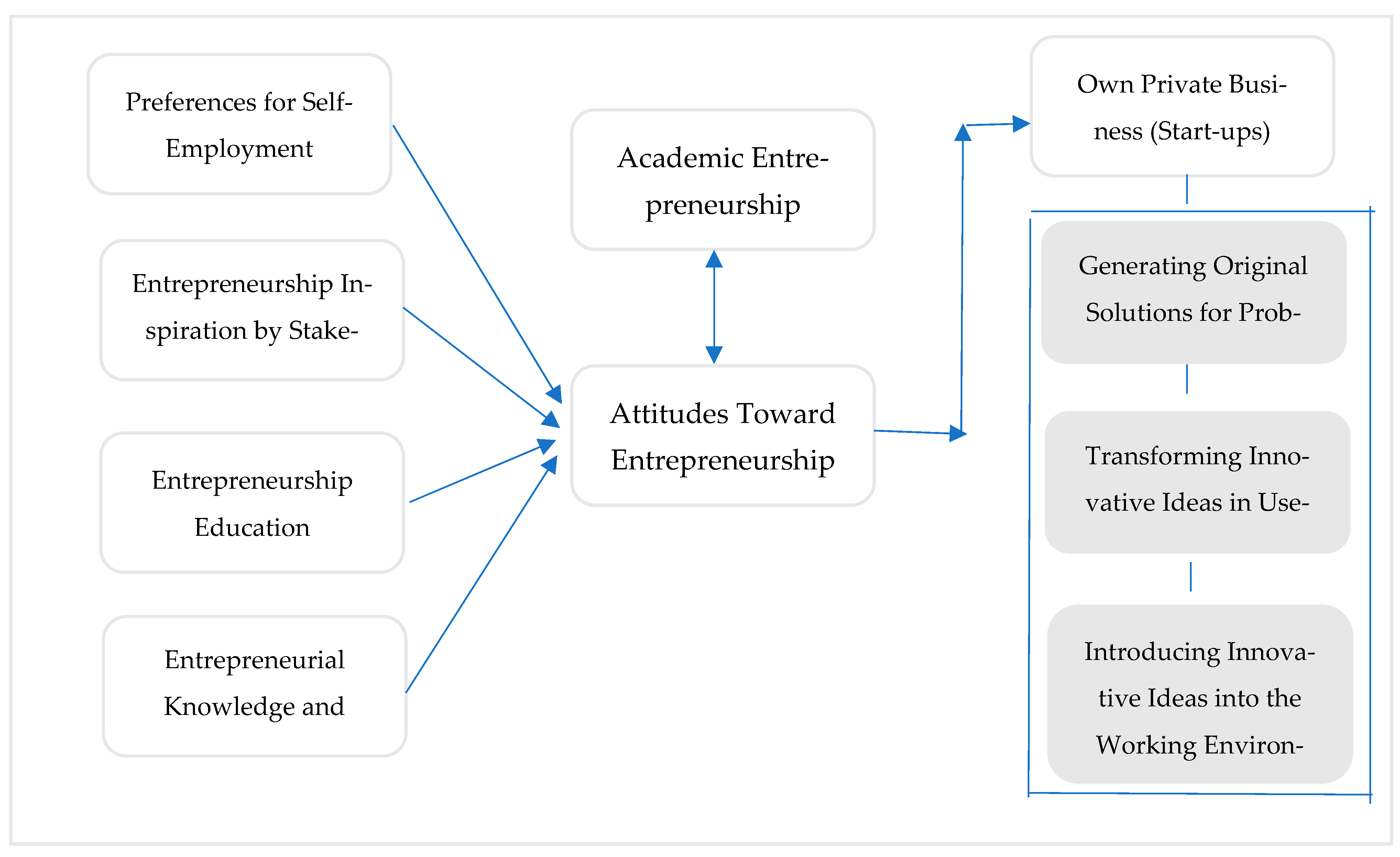

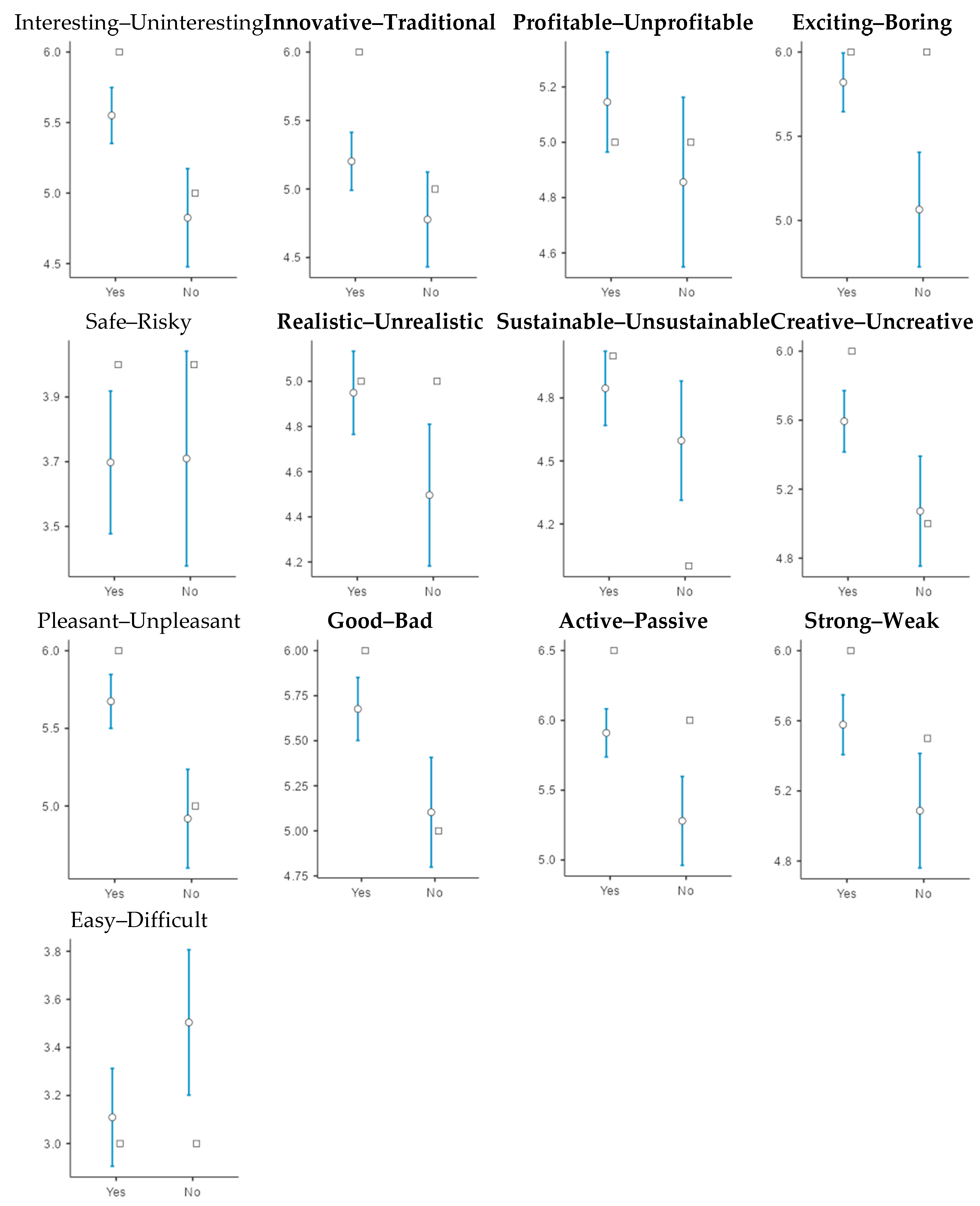
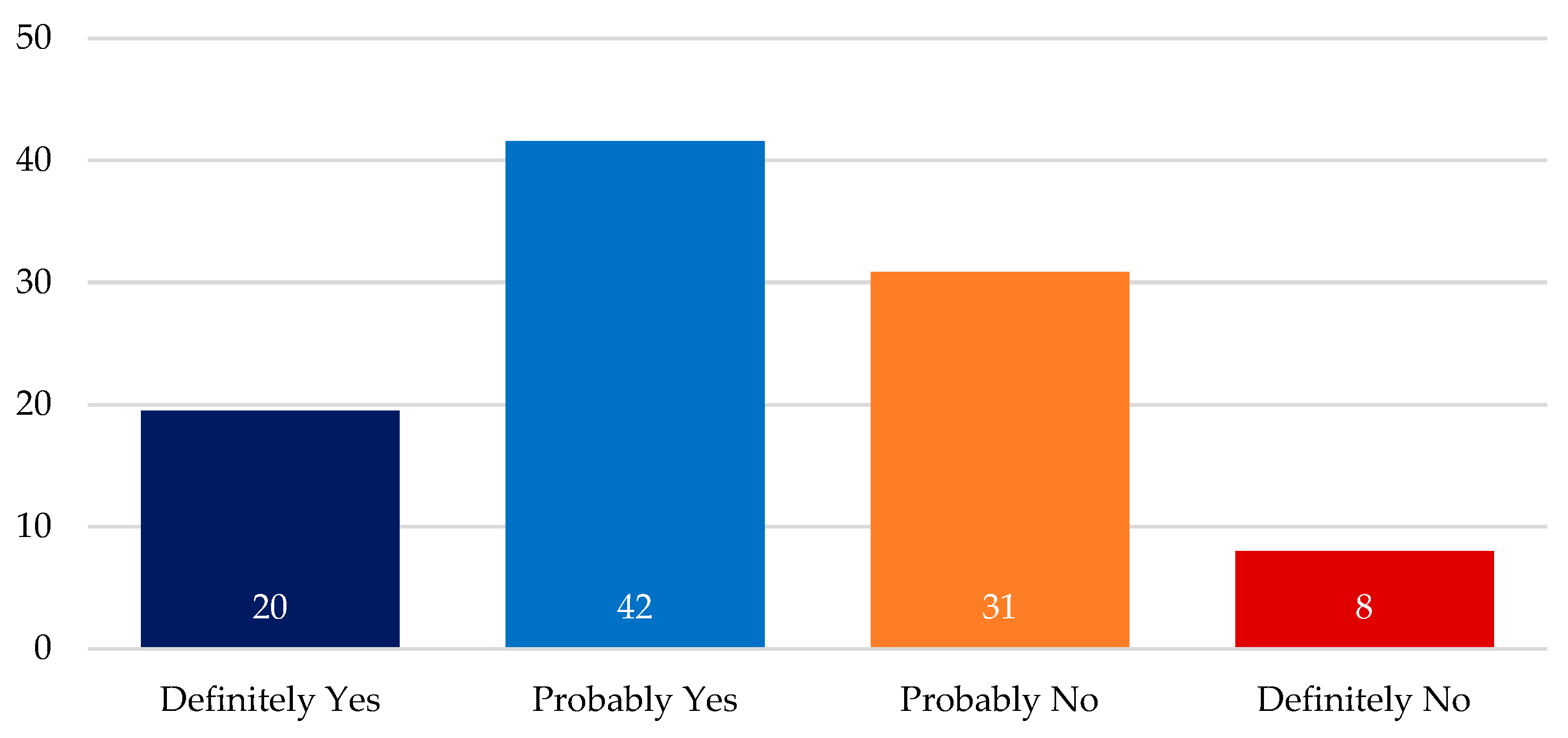
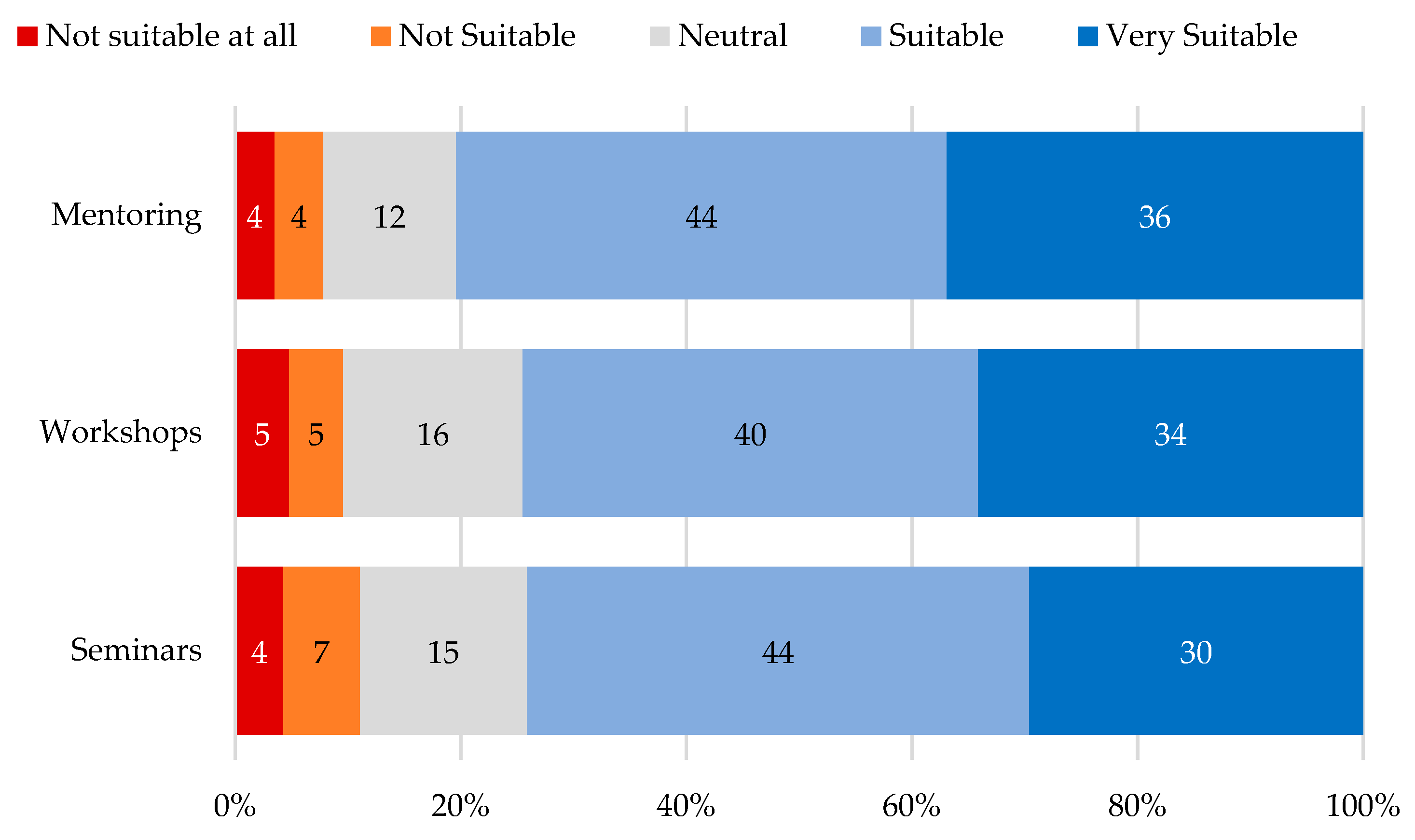
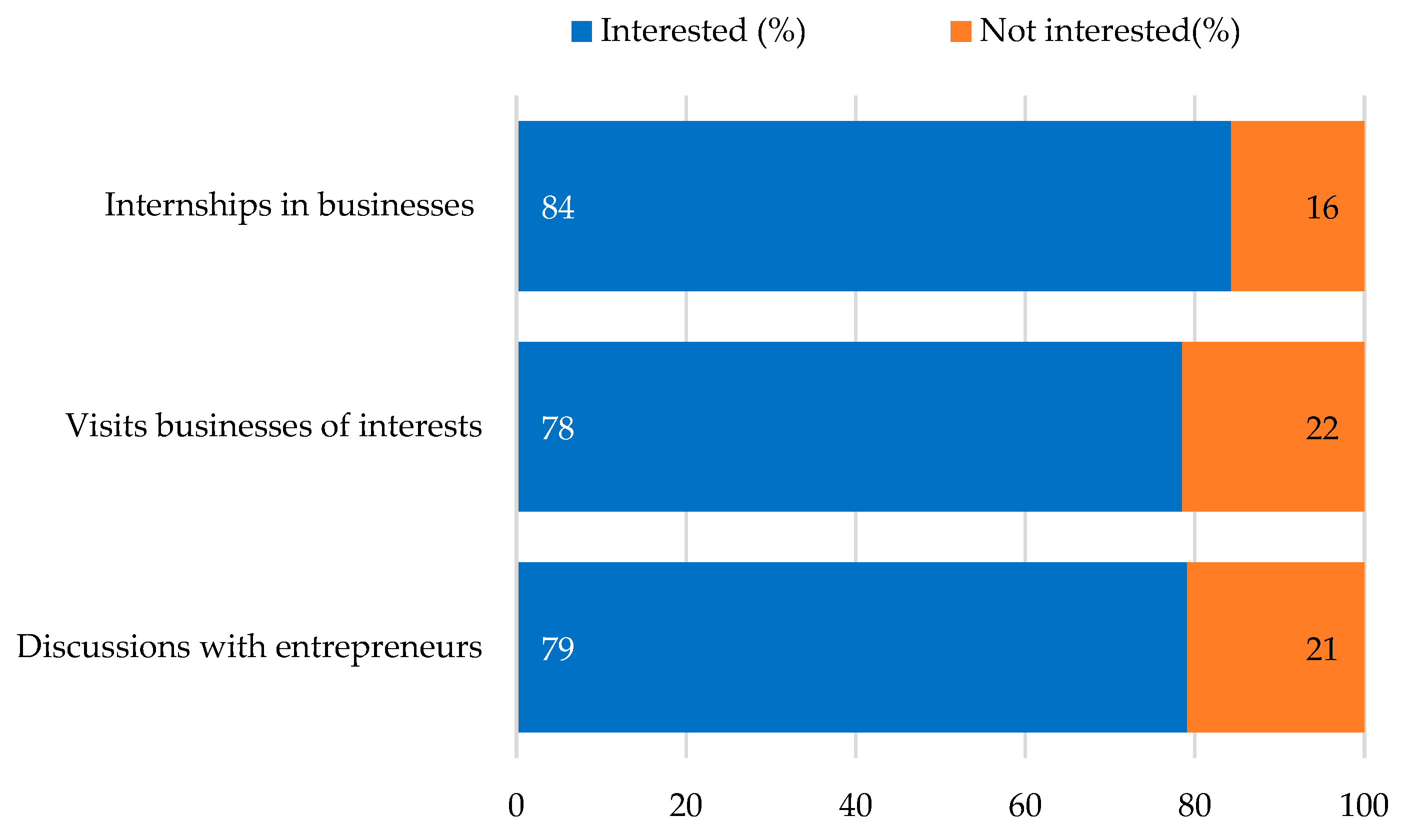
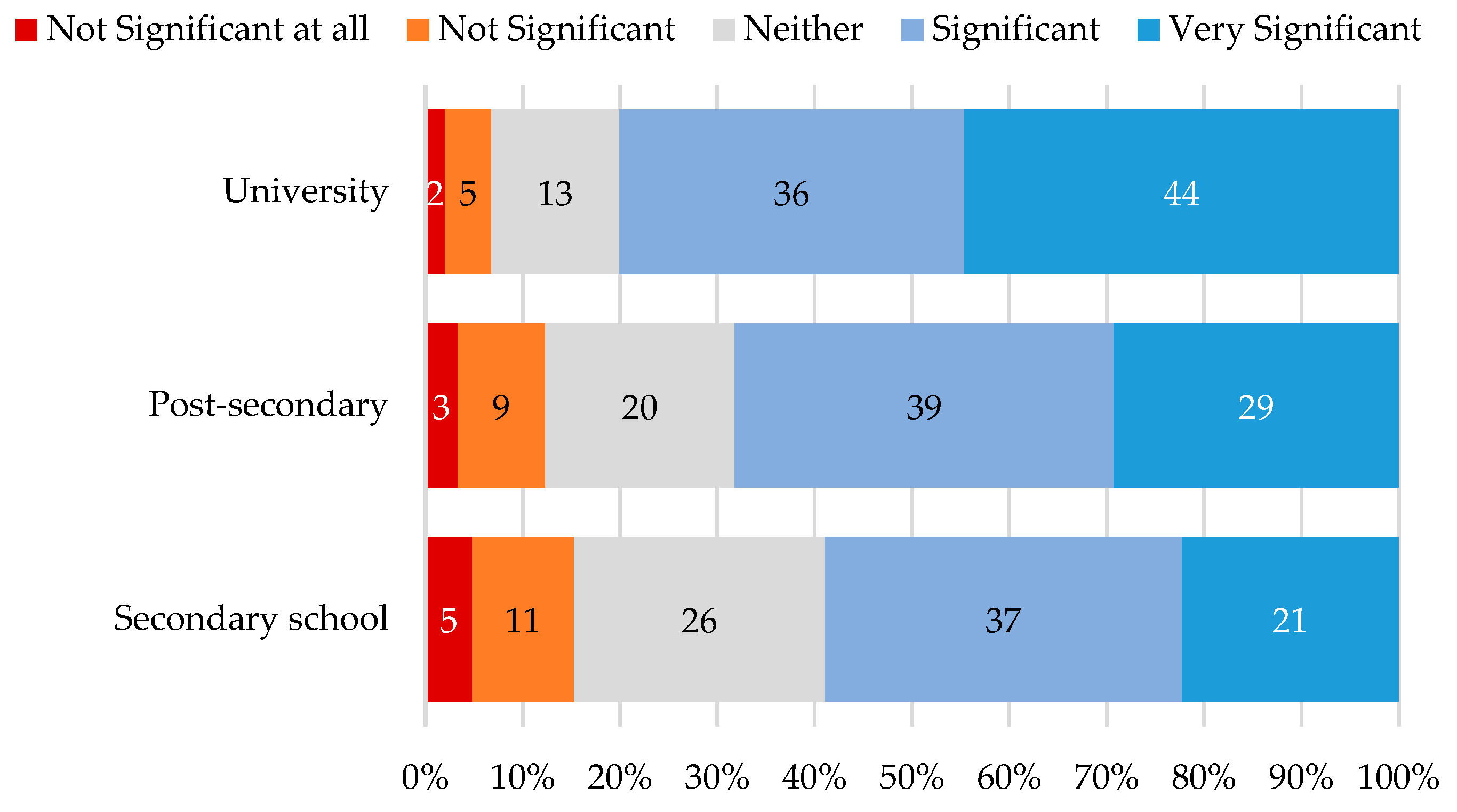
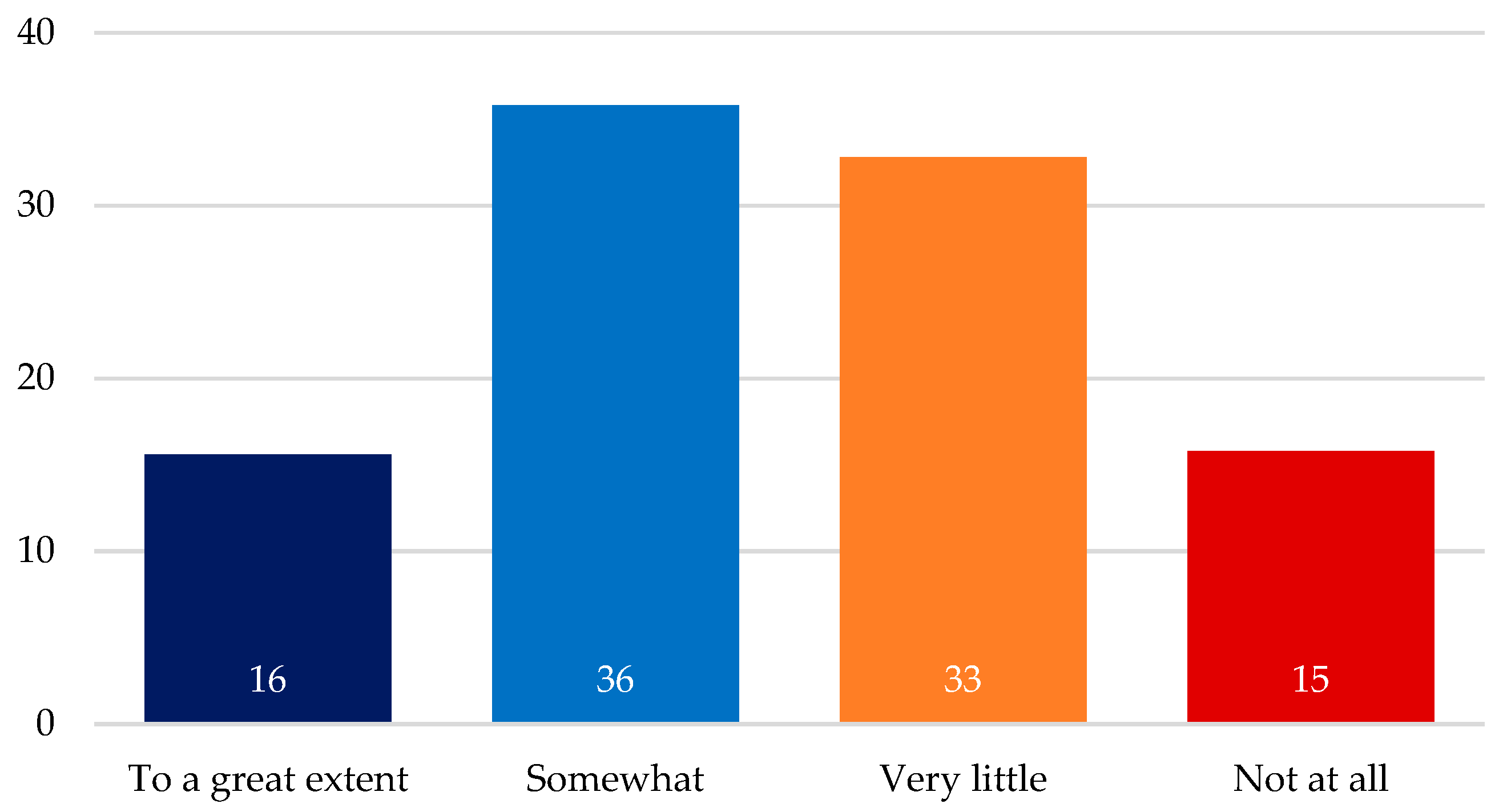
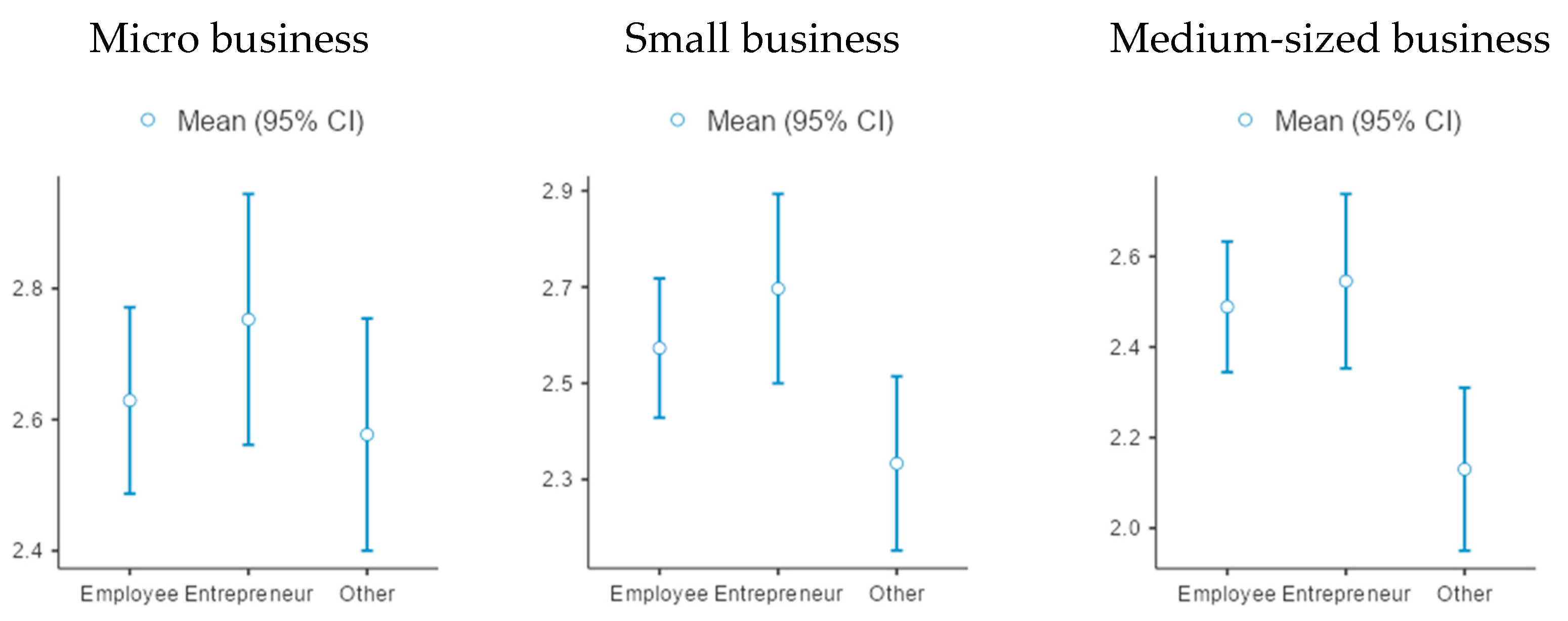
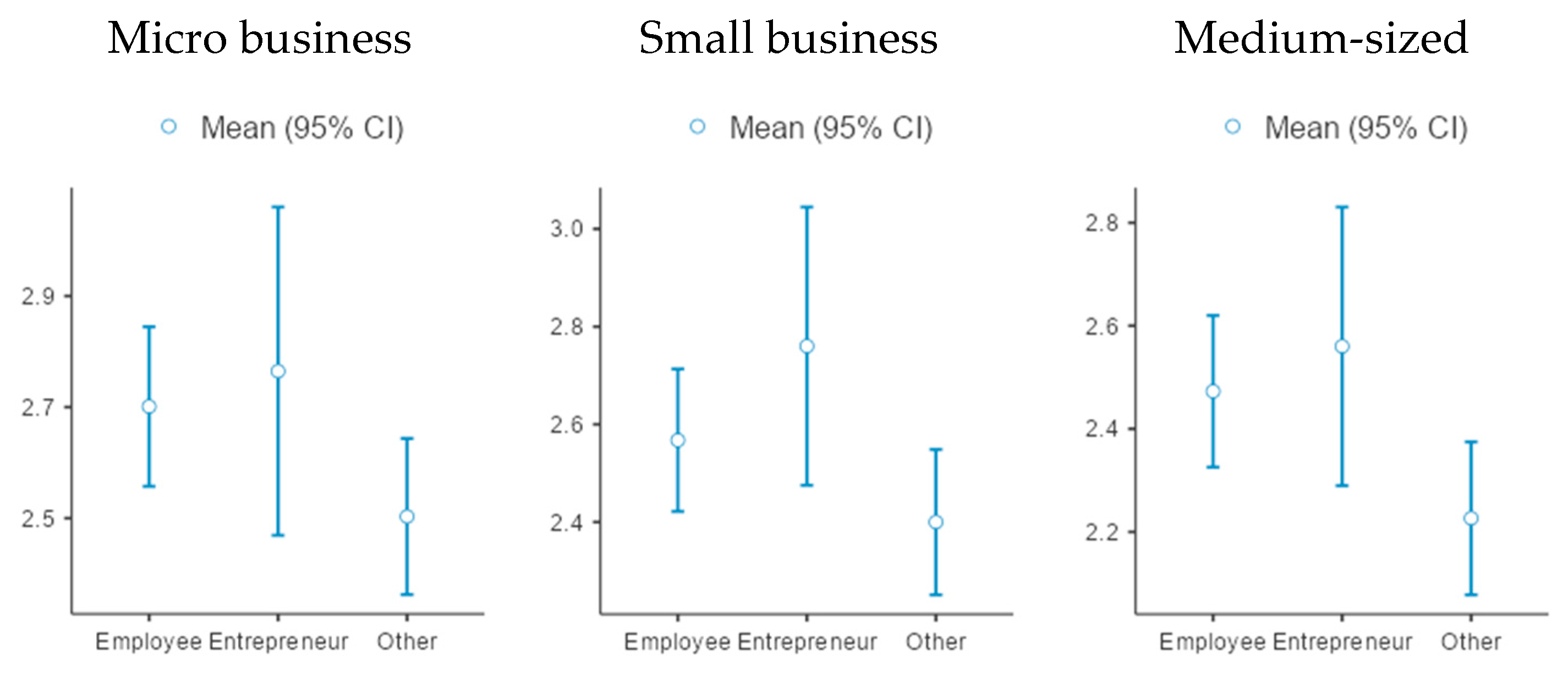
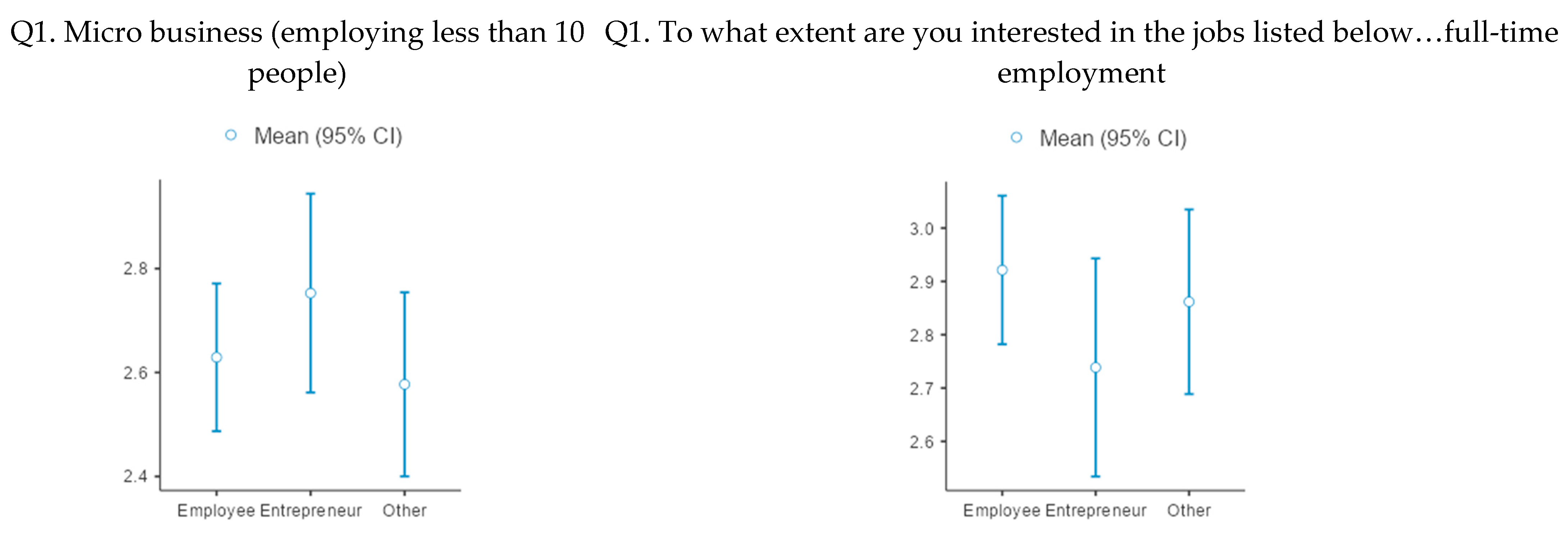

| Cronbach’s α | McDonald’s ω | |
|---|---|---|
| scale | 0.909 | 0.920 |
| Own Business | Item–Rest Correlation | If the Item Dropped, Cronbach’s α |
|---|---|---|
| Interesting–Uninteresting | 0.634 | 0.902 |
| Innovative–Traditional | 0.611 | 0.904 |
| Profitable–Unprofitable | 0.645 | 0.902 |
| Exciting–Boring | 0.761 | 0.897 |
| Safe–Risky | 0.349 | 0.915 |
| Realistic–Unrealistic | 0.671 | 0.901 |
| Sustainable–Unsustainable | 0.671 | 0.901 |
| Creative–Uncreative | 0.680 | 0.900 |
| Pleasant–Unpleasant | 0.807 | 0.895 |
| Good–Bad | 0.793 | 0.896 |
| Active–Passive | 0.735 | 0.898 |
| Strong–Weak | 0.803 | 0.895 |
| Easy–Difficult | 0.141 | 0.923 |
| Cronbach’s α | McDonald’s ω | |
|---|---|---|
| Scale | 0.923 | 0.926 |
| Item–Rest Correlation | If Item Dropped, Cronbach’s α | |
|---|---|---|
| Interesting–Uninteresting | 0.667 | 0.917 |
| Innovative–Traditional | 0.620 | 0.919 |
| Profitable–Unprofitable | 0.696 | 0.916 |
| Exciting–Boring | 0.784 | 0.913 |
| Safe–Risky | 0.436 | 0.925 |
| Realistic–Unrealistic | 0.529 | 0.922 |
| Sustainable–Unsustainable | 0.635 | 0.918 |
| Creative–Uncreative | 0.721 | 0.915 |
| Pleasant–Unpleasant | 0.801 | 0.912 |
| Good–Bad | 0.802 | 0.912 |
| Active–Passive | 0.647 | 0.918 |
| Strong–Weak | 0.775 | 0.913 |
| Easy–Difficult | 0.545 | 0.921 |
| Contingency Tables | |||
|---|---|---|---|
| Q5_New Q5 Intentions for Own Business | |||
| Q1R1 Preferences for Full-Time Employment | Yes | No | Total |
| Not interested at all | 70.7% | 29.3% | 100.0% |
| Not interested | 57.6% | 42.4% | 100.0% |
| Interested | 64.6% | 35.4% | 100.0% |
| Very interested | 78.3% | 21.7% | 100.0% |
| Total | 67.5% | 32.5% | 100.0% |
| Intentions for Own Business | Intentions for Own Business | ||||
|---|---|---|---|---|---|
| Part-Time Employment | Yes (%) | No (%) | Self-Employment | Yes | No |
| Not interested at all | 10.6 | 6.0 | Not interested at all | 8.4 | 11.4 |
| Not interested | 18.3 | 22.6 | Not interested | 17.2 | 27.3 |
| Interested | 49.8 | 54.9 | Interested | 46.4 | 39.4 |
| Very interested | 21.2 | 16.5 | Very interested | 28.1 | 22.0 |
| χ2 = 4.35 | χ2 = 7.56 | ||||
| Own Business | Student’s t | df | p | Cohen’s d Effect Size |
|---|---|---|---|---|
| Interesting–Uninteresting | 0.719 | 401 | 0.473 | 0.0774 |
| Innovative–Traditional | −0.112 | 400 | 0.911 | −0.0121 |
| Profitable–Unprofitable | 0.682 | 400 | 0.496 | 0.0737 |
| Exciting–Boring | 0.319 | 398 | 0.750 | 0.0344 |
| Safe–Risky | 3.902 | 400 | <0.001 | 0.4195 |
| Realistic–Unrealistic | 2.796 | 400 | 0.005 | 0.3013 |
| Sustainable–Unsustainable | 1.697 | 400 | 0.090 | 0.1833 |
| Creative–Uncreative | 0.396 | 398 | 0.693 | 0.0428 |
| Pleasant–Unpleasant | 2.207 | 397 | 0.028 | 0.2392 |
| Good–Bad | 1.557 | 398 | 0.120 | 0.1687 |
| Active–Passive | 1.397 | 400 | 0.163 | 0.1506 |
| Strong–Weak | 2.288 | 400 | 0.023 | 0.2465 |
| Easy–Difficult | 1.394 | 397 | 0.164 | 0.1512 |
| Own Business | Group | N | Mean | SD | SE |
|---|---|---|---|---|---|
| Interesting–Uninteresting | Yes | 278 | 3.78 | 1.78 | 0.1070 |
| No | 125 | 3.65 | 1.71 | 0.153 | |
| Innovative–Traditional | Yes | 279 | 3.20 | 1.88 | 0.1124 |
| No | 123 | 3.22 | 1.77 | 0.160 | |
| Profitable–Unprofitable | Yes | 278 | 4.05 | 1.74 | 0.1045 |
| No | 124 | 3.93 | 1.66 | 0.149 | |
| Exciting–Boring | Yes | 276 | 3.70 | 1.69 | 0.1015 |
| No | 124 | 3.65 | 1.65 | 0.149 | |
| Safe–Risky | Yes | 276 | 5.21 | 1.52 | 0.0918 |
| No | 126 | 4.54 | 1.72 | 0.154 | |
| Realistic–Unrealistic | Yes | 277 | 5.14 | 1.58 | 0.0950 |
| No | 125 | 4.66 | 1.67 | 0.149 | |
| Sustainable–Unsustainable | Yes | 278 | 4.65 | 1.53 | 0.0917 |
| No | 124 | 4.36 | 1.60 | 0.144 | |
| Creative–Uncreative | Yes | 276 | 3.48 | 1.77 | 0.1067 |
| No | 124 | 3.40 | 1.71 | 0.154 | |
| Pleasant–Unpleasant | Yes | 276 | 4.01 | 1.68 | 0.1011 |
| No | 123 | 3.62 | 1.61 | 0.145 | |
| Good–Bad | Yes | 277 | 4.32 | 1.60 | 0.0959 |
| No | 123 | 4.06 | 1.50 | 0.135 | |
| Active–Passive | Yes | 277 | 4.23 | 1.64 | 0.0984 |
| No | 125 | 3.99 | 1.55 | 0.139 | |
| Strong–Weak | Yes | 277 | 4.23 | 1.51 | 0.0907 |
| No | 125 | 3.86 | 1.50 | 0.134 | |
| Easy–Difficult | Yes | 276 | 4.07 | 1.65 | 0.0994 |
| No | 123 | 3.82 | 1.61 | 0.145 |
| (a) | |||||
| Employment | Student’s t-Test | df | p | Cohen’s d Effect Size | |
| Interesting–Uninteresting | 3.7787 | 402 | <0.001 | 0.40581 | |
| Innovative–Traditional | 2.1255 | 401 | 0.034 | 0.22840 | |
| Profitable–Unprofitable | 1.6765 | 398 | 0.094 | 0.18085 | |
| Exciting–Boring | 4.2773 | 400 | <0.001 | 0.46190 | |
| Safe–Risky | −0.0583 | 400 | 0.954 | −0.00629 | |
| Realistic–Unrealistic | 2.5707 | 398 | 0.011 | 0.27730 | |
| Sustainable–Unsustainable | 1.4978 | 401 | 0.135 | 0.16165 | |
| Creative–Uncreative | 2.9984 | 400 | 0.003 | 0.32379 | |
| Pleasant–Unpleasant | 4.4071 | 400 | <0.001 | 0.47699 | |
| Good–Bad | 3.3995 | 402 | <0.001 | 0.36509 | |
| Active–Passive | 3.6977 | 401 | <0.001 | 0.39820 | |
| Strong–Weak | 2.8644 ᵃ | 401 | 0.004 | 0.30779 | |
| Easy–Difficult | −2.1243 | 398 | 0.034 | −0.22916 | |
| (b) | |||||
| Employment | Q5_new | N | Mean | SD | SE |
| Interesting–Uninteresting | Yes | 278 | 5.55 | 1.69 | 0.1011 |
| No | 126 | 4.83 | 1.99 | 0.177 | |
| Innovative–Traditional | Yes | 277 | 5.20 | 1.80 | 0.1081 |
| No | 126 | 4.78 | 1.98 | 0.177 | |
| Profitable–Unprofitable | Yes | 275 | 5.15 | 1.53 | 0.0922 |
| No | 125 | 4.86 | 1.75 | 0.156 | |
| Exciting–Boring | Yes | 278 | 5.82 | 1.49 | 0.0891 |
| No | 124 | 5.06 | 1.93 | 0.174 | |
| Exciting–Boring | Yes | 278 | 3.70 | 1.88 | 0.1126 |
| No | 124 | 3.71 | 1.89 | 0.169 | |
| Realistic–Unrealistic | Yes | 275 | 4.95 | 1.56 | 0.0940 |
| No | 125 | 4.50 | 1.79 | 0.160 | |
| Sustainable–Unsustainable | Yes | 279 | 4.85 | 1.51 | 0.0903 |
| No | 124 | 4.60 | 1.61 | 0.145 | |
| Creative–Uncreative | Yes | 278 | 5.59 | 1.51 | 0.0907 |
| No | 124 | 5.07 | 1.81 | 0.162 | |
| Pleasant–Unpleasant | Yes | 279 | 5.67 | 1.48 | 0.0885 |
| No | 123 | 4.92 | 1.80 | 0.162 | |
| Good–Bad | Yes | 278 | 5.68 | 1.49 | 0.0891 |
| No | 126 | 5.10 | 1.74 | 0.155 | |
| Active–Passive | Yes | 278 | 5.91 | 1.47 | 0.0879 |
| No | 125 | 5.28 | 1.82 | 0.162 | |
| Strong–Weak | Yes | 277 | 5.58 | 1.45 | 0.0871 |
| No | 126 | 5.09 | 1.87 | 0.167 | |
| Easy–Difficult | Yes | 275 | 3.11 | 1.72 | 0.1039 |
| No | 125 | 3.50 | 1.73 | 0.154 | |
| Not Significant at All | Not Significant | Neither | Significant | Very Significant | |
|---|---|---|---|---|---|
| Secondary school | 5 | 11 | 26 | 37 | 22 |
| Post-secondary | 3 | 9 | 20 | 39 | 29 |
| University | 2 | 5 | 13 | 36 | 45 |
| One-Way ANOVA (Welch’s) | |||||
|---|---|---|---|---|---|
| F | df1 | df2 | p | ||
| Micro business | 0.935 | 2 | 220 | 0.394 | |
| Small business | 3.889 | 2 | 220 | 0.022 | |
| Medium-sized | 6.256 | 2 | 219 | 0.002 | |
| Q33.1dv—Father’s employment status | N | Mean | SD | SE | |
| Micro business | Employee | 178 | 2.63 | 0.961 | 0.0720 |
| Entrepreneur | 89 | 2.75 | 0.908 | 0.0963 | |
| Other | 123 | 2.58 | 0.992 | 0.0894 | |
| Small business | Employee | 178 | 2.57 | 0.979 | 0.0734 |
| Entrepreneur | 89 | 2.70 | 0.934 | 0.0990 | |
| Other | 123 | 2.33 | 1.014 | 0.0914 | |
| Medium-sized | Employee | 178 | 2.49 | 0.976 | 0.0731 |
| Entrepreneur | 88 | 2.55 | 0.909 | 0.0969 | |
| Other | 123 | 2.13 | 1.008 | 0.0909 | |
| One-Way ANOVA (Welch’s) | ||||||
|---|---|---|---|---|---|---|
| F | df1 | df2 | p | |||
| Micro business | 2.44 | 2 | 137 | 0.091 | ||
| Small business | 2.90 | 2 | 137 | 0.058 | ||
| Medium-sized | 3.74 | 2 | 140 | 0.026 | ||
| Q33.2dv—Mother’s employment status | N | Mean | SD | SE | ||
| Micro business | Employee | 184 | 2.70 | 0.988 | 0.0728 | |
| Entrepreneur | 51 | 2.76 | 1.050 | 0.1471 | ||
| Other | 161 | 2.50 | 0.902 | 0.0711 | ||
| Small business | Employee | 185 | 2.57 | 1.004 | 0.0738 | |
| Entrepreneur | 50 | 2.76 | 1.001 | 0.1416 | ||
| Other | 160 | 2.40 | 0.953 | 0.0753 | ||
| Medium-sized | Employee | 184 | 2.47 | 1.013 | 0.0747 | |
| Entrepreneur | 50 | 2.56 | 0.951 | 0.1345 | ||
| Other | 159 | 2.23 | 0.948 | 0.0751 | ||
| One-Way ANOVA (Welch’s) | ||||
|---|---|---|---|---|
| F | df1 | df2 | p | |
| Q1R6 | 0.935 | 2 | 220 | 0.394 |
| Q1R1 | 1.070 | 2 | 214 | 0.345 |
| Father’s Employment Status | N | Mean | SD | SE | |
|---|---|---|---|---|---|
| Q1R6. Interest in micro business | Employee | 178 | 2.63 | 0.961 | 0.0720 |
| Entrepreneur | 89 | 2.75 | 0.908 | 0.0963 | |
| Other | 123 | 2.58 | 0.992 | 0.0894 | |
| Interest in full-time employment | Employee | 178 | 2.92 | 0.942 | 0.0706 |
| Entrepreneur | 88 | 2.74 | 0.965 | 0.1029 | |
| Other | 123 | 2.86 | 0.969 | 0.0874 |
| One-Way ANOVA (Welch’s) | ||||
|---|---|---|---|---|
| F | df1 | df2 | p | |
| Q1R6 | 2.442 | 2 | 137 | 0.091 |
| Q1R1 | 0.176 | 2 | 131 | 0.839 |
| Q33.2dv—Mother’s Employment Status | N | Mean | SD | SE | |
|---|---|---|---|---|---|
| Q1R6. Interest in micro business | Employee | 184 | 2.70 | 0.988 | 0.0728 |
| Entrepreneur | 51 | 2.76 | 1.050 | 0.1471 | |
| Other | 161 | 2.50 | 0.902 | 0.0711 | |
| Q1R1. Interest in full-time employment | Employee | 185 | 2.88 | 1.004 | 0.0738 |
| Entrepreneur | 50 | 2.78 | 1.093 | 0.1546 | |
| Other | 159 | 2.86 | 0.841 | 0.0667 |
Disclaimer/Publisher’s Note: The statements, opinions and data contained in all publications are solely those of the individual author(s) and contributor(s) and not of MDPI and/or the editor(s). MDPI and/or the editor(s) disclaim responsibility for any injury to people or property resulting from any ideas, methods, instructions or products referred to in the content. |
© 2025 by the authors. Licensee MDPI, Basel, Switzerland. This article is an open access article distributed under the terms and conditions of the Creative Commons Attribution (CC BY) license (https://creativecommons.org/licenses/by/4.0/).
Share and Cite
Angelova, M.N.; Pastarmadzhieva, D.D.; Raykov, M.; Eryaman, M.Y.; Riedler, M. A Comparative Analysis of Academic Entrepreneurship Research: The Cases of Bulgaria, Malta, and Turkey. Sustainability 2025, 17, 5907. https://doi.org/10.3390/su17135907
Angelova MN, Pastarmadzhieva DD, Raykov M, Eryaman MY, Riedler M. A Comparative Analysis of Academic Entrepreneurship Research: The Cases of Bulgaria, Malta, and Turkey. Sustainability. 2025; 17(13):5907. https://doi.org/10.3390/su17135907
Chicago/Turabian StyleAngelova, Mina Nikolaeva, Daniela Dobreva Pastarmadzhieva, Milosh Raykov, Mustafa Yunus Eryaman, and Martina Riedler. 2025. "A Comparative Analysis of Academic Entrepreneurship Research: The Cases of Bulgaria, Malta, and Turkey" Sustainability 17, no. 13: 5907. https://doi.org/10.3390/su17135907
APA StyleAngelova, M. N., Pastarmadzhieva, D. D., Raykov, M., Eryaman, M. Y., & Riedler, M. (2025). A Comparative Analysis of Academic Entrepreneurship Research: The Cases of Bulgaria, Malta, and Turkey. Sustainability, 17(13), 5907. https://doi.org/10.3390/su17135907








